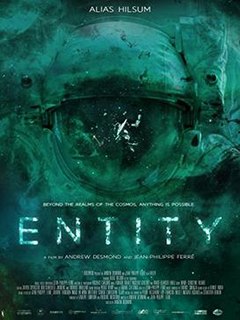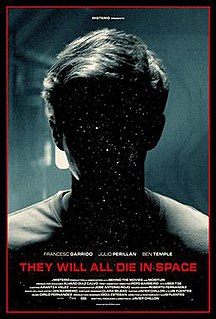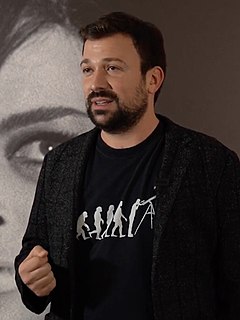Related Research Articles

William Francis Nolan was an American author who wrote hundreds of stories in the science fiction, fantasy, horror, and crime fiction genres.
Antonio Margheriti, also known under the pseudonyms Anthony M. Dawson and Antony Daisies, was an Italian filmmaker. Margheriti worked in many different genres in the Italian film industry, and was known for his sometimes derivative but often stylish and entertaining science fiction, sword and sandal, horror/giallo, Eurospy, Spaghetti Western, Vietnam War and action movies that were released to a wide international audience. He died in 2002.

James Francis Gunn Jr. is an American filmmaker and actor. He began his career as a screenwriter in the mid-1990s, starting at Troma Entertainment with Tromeo and Juliet (1997). He then began working as a director, starting with the horror-comedy film Slither (2006), and moving to the superhero genre with Super (2010), Guardians of the Galaxy (2014), Guardians of the Galaxy Vol. 2 (2017), The Suicide Squad (2021), and Guardians of the Galaxy Vol. 3 (2023).

The Leeds International Film Festival (LIFF) is the largest film festival in England outside London. Founded in 1987, it is held in November at various venues throughout Leeds, West Yorkshire. In 2015, the festival welcomed over 40,000 visitors and showed over 300 films from around the world, shorts and features, both commercial and independent.

Gabbia is a 2003 independent short-film directed by Italian filmmaker Francesco Roder, who also wrote the script. It stars Mexican actress Claudia Soberón.
Michael Gingold is an American journalist, screenwriter, and former editor-in-chief of Fangoria magazine.

Joe Lynch is an American film and music video director, film producer, cinematographer, and actor.

Dekker Dreyer is an American filmmaker, artist, and composer also known as Phantom Astronaut. He is a prominent creator in virtual and augmented reality.

Worker Studio is an American animation and visual effects company based in Centennial, Colorado, founded in 2009 by Michael "Ffish" Hemschoot. The company has provided visual effects for a number of short films including Angela Bettis' segment E is for Exterminate in the horror anthology film The ABCs of Death. In 2013, the studio began developing an animated adaptation of Phil Hartman's comedy album, Phil Hartman's Flat TV, which was posthumously released in 2002 after he performed and recorded it in 1978. The studio is also the production company behind the animated documentary John Ross: American, based on the life of World War II pilot John H. Ross.

Mike Flanagan is an American filmmaker and partner in Intrepid Pictures. Flanagan's work has attracted the praise of critics for his directing and lack of reliance on jump scares. Stephen King, Quentin Tarantino, and William Friedkin, among others, have praised him.

Trieste Science+Fiction Festival was founded in 2000 under the name of Science plus Fiction by the Research and Experimentation Centre La Cappella Underground with the ambitious purpose of re-launching the Festival Internazionale del film di fantascienza, which had been held in the northern Italian city of Trieste in the years 1963–1982.

Gigi Saul Guerrero is a Mexican filmmaker and actress. She gained recognition for creating and directing the 2017 horror web series, La Quinceañera. In 2019, she directed episodes of The Purge and the anthology horror series, Into the Dark.

Entity is a 2014 English-language French short science-fiction horror film directed by Andrew Desmond and co-written by Jean-Phillipe Ferré about an astronaut who is stranded in deep space and has a close encounter with a sentient entity in the form of a nebula. Entity is Desmond's third film, the previous two also being shorts, Doppelganger and Epilogue. The first French short film to have its sound mixed in Dolby Atmos, Entity has been selected for over eighty film festivals and received, among other honours, a Best Visual Effects Award from both the Hollywood Horror Fest and the FilmQuest Film Festival. Reviews have been favourable, particularly for the short's visual effects.

They Will All Die in Space is a 2015 English-language Spanish short science-fiction horror film written, directed and produced by Javier Chillon, about a starship technician who is awoken from cryo-sleep and is told that the vessel is adrift and lost in the cosmos, and that he is needed to help repair the communications system to call for help, but quickly realises that something has gone horrifyingly wrong. Chillon's third short film was shown at well over 300 film festivals between 2015 and the end of 2019, and has won approximately sixty awards and honours, including Best Short Film from the 2015 Sitges Film Festival, the most important fantastic film festival in Spain.

Antonio Padovan is an Italian-born film director, producer, screenwriter, and video artist who lives in New York City, known for his short films Socks and Cakes (2010), Jack Attack (2013), Eveless (2016), and his first feature, The Last Prosecco (2017). His video Japan, Beyond (2012) won the first prize at the Stand for Japan Awards, while Jack Attack was selected by more than fifty international film festivals and won dozens of awards and other honors. He was born and raised in the Veneto region, near Venice, but has called New York's West Village home since 2007, and is the co-founder of the Greenwich Village Film Festival.

Eveless is a 2016 American short science-fiction horror film directed and co-written by Antonio Padovan about two men living in a world without women who attempt to create one with only the limited resources they have gathered. Stars Vin Kridakorn and Greg Engbrecht were also the short's executive producers.

Kingz is a 2007 German short action science-fiction horror film created by Benni Diez and Marinko Spahić about two young thugs who go to a nightclub to close out a drug deal only to find something is not quite right about some of the patrons, including the owner ; the ensuing mayhem involves martial arts, swordplay, and gunfighting. The short film was shown at international film festivals and won a Méliès d'Argent in 2009.

Galaxy of Horrors is a 2017 Canadian science-fiction horror anthology film consisting of eight short films within larger "wraparound" framing sequences before and after each of the shorts, in which a man wakes from a cryogenic sleep pod and is forced to watch the films as entertainment while his life-support runs out. The shorts are by international filmmakers such as Antonio Padovan, Javier Chillon, Benni Diez and Marinko Spahić, while Justin McConnell directed the wraparound.
Artex Film is an Italian film production and distribution company founded in 2017.
References
- 1 2 3 4 5 6 7 8 9 "Pathos". Vimeo . Illusion. 14 February 2014. Retrieved 4 February 2019.
- 1 2 3 4 "Pathos". LaboCine (in Italian). Retrieved 5 February 2019.
- 1 2 3 4 "Selected Works". Illusion Video Production. Retrieved 4 February 2019.
- ↑ Gossett, Denise. "Shriekfest Radio! Denise Gossett interviews star of Eveless, Vin Kridakorn!" (podcast and text). Blog Talk Radio. Retrieved 5 March 2019.
- 1 2 3 4 5 6 7 Norese, Marianna (17 February 2009). "La fantascienza sbarca in Liguria". Mentelocale (in Italian). Retrieved 9 February 2019.
- 1 2 3 4 5 Ferrara, Pia. "Corti – Pacchetto Viola (Ultracorpo, Pathos, La città nel cielo)". www.fantascienza.com (in Italian). Retrieved 5 February 2019.
- 1 2 3 Howk, Hans. "Galaxy of Horrors (Movie Review)". Cryptic Rock. Retrieved 5 February 2019.
- 1 2 3 4 5 6 7 "Avanti con 'Pathos' obiettivo festival". La Repubblica (in Italian). 15 February 2009. Retrieved 9 February 2019.
- 1 2 3 4 Paşcalău, Cristian. "The Death of Individual Freedom and its Mass Effects over the Young Generation in Roberto Faenza's H2S". Phantasma. Retrieved 5 February 2019.
- 1 2 3 Facchin, Andrea (17 February 2014). "Pathos, l'acclamato corto sci-fi made in Italy da oggi disponibile gratis online. Guarda il video". Best Movie (in Italian). Retrieved 5 February 2019.
- 1 2 3 4 5 Grassi, Raffaella (2009). "Pathos, fantascienza made in Genova" (scanned news clipping, month and date not provided)). Il Secolo XIX (in Italian). Retrieved 9 February 2019.
- 1 2 3 "Is the future real? STUNNING teaser for scifi dystopian short film PATHOS". Quiet Earth. Retrieved 4 February 2019.
- 1 2 Tomasi, Rollo. "PATHOS (2010) Short Film Trailer, Poster: Dennis Cabella". FilmBook. Retrieved 4 February 2019.
- 1 2 Adelgaard, Karina. "Galaxy of Horrors (3/5)". Heaven of Horror. Retrieved 2 February 2019.
- 1 2 "Arcipelago 2009 Festival Internazionale di Cortometraggi e Nuove Immagini". www.teatrostudio.org. Retrieved 8 February 2019.
- 1 2 Marcusa, Anthony. "Lost in Space: Our Review of 'Galaxy of Horrors'". In the Seats. Retrieved 4 May 2019.
- 1 2 3 4 5 6 7 8 9 10 11 12 13 14 Alberini, Sergio (interviewer) (30 May 2019). "PATHOS a short film". La Frontiera Scomparsa (in Italian). Retrieved 5 February 2019.
{{cite journal}}:|first1=has generic name (help) - 1 2 3 4 5 Quattrini, Elianna (2019). "Futuro da incubo, se no paghi ti tagliano i sensi" (scanned clipping, month and date not provided). Corriere Mercantile (in Italian). Retrieved 9 February 2019.
- 1 2 3 4 5 6 7 "Da oggi, al cinema, uscirà in alcune selezionate sale italiane la prima raccolta di cortometraggi "Pacchetto Corti – Viola"". www.horror.it (in Italian). 30 May 2009. Retrieved 6 February 2019.
- ↑ I've Seen Films International Film Festival, Third Edition (PDF). [Milan]: [I've Seen Films International Film Festival]. 2010. p. 228. Retrieved 6 February 2019.
- ↑ Baroncelli, Francesca (25 June 2009). "Genova Film Festival 2009". Mentelocale Genova. Retrieved 9 February 2019.
- 1 2 "Pathos: sci-fi made in Italy". Cinefilos (in Italian). Retrieved 9 February 2019.
- 1 2 "Distribuzione Indipendente Horror/Thriller/Fantascienza: 3 cortometraggi del Pacchetto Viola". BlogO (in Italian). Retrieved 6 February 2019.
- 1 2 "Fanomenon - Leeds International Film Festival". www.melies.org. European Fantastic Film Festivals Federation. Retrieved 4 February 2019.
- 1 2 Quaranta, Anna. "Corti – Pacchetto Viola: "Ultracorpo", "Pathos", "La Città Nel Cielo"". www.taxidrivers.it (in Italian). TXDRVRS. Retrieved 5 February 2019.
- ↑ "Galaxy of Horrors - Toronto Screening". www.blogto.com. Retrieved 4 February 2019.
- ↑ "Galaxy of Horrors – Canada, 2017". Horrorpedia. Retrieved 2 February 2019.
- 1 2 Sopko, Richard. "Film Review: Galaxy of Horrors (2017)". www.horrornews.net. Retrieved 2 February 2019.
- ↑ "Galaxy of Horrors". indiecanent.com. IndieCan Entertainment. Retrieved 2 February 2019.
- ↑ "Galaxy of Horrors (2017) Movie". Hell Horror. Retrieved 4 February 2019.
- ↑ "Galaxy Of Horrors". Amazon Prime . Retrieved 2 February 2019.
- ↑ Fisher, Carl. "Horror Movie Review: Galaxy of Horrors (2017)". gbhbl.com. Retrieved 2 February 2019.
- ↑ "FANCINE PREMIOS- Festival de Cine Fantástico de la UMA – Acta del Jurado Joven". externos.uma.es (in Spanish). University of Malaga . Retrieved 8 February 2019.
- ↑ "I've Seen Films 2010 - The Awards, the Guests, the Artists, and all the Festival numbers!" (PDF). www.icfilms.org. Retrieved 9 February 2019.
- ↑ Zampa, Alice. "I've Seen Films, tutti i vincitori e le foto della Serata di Gala". Best Movie (in Italian). Retrieved 8 February 2019.